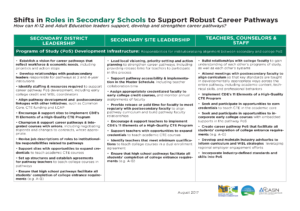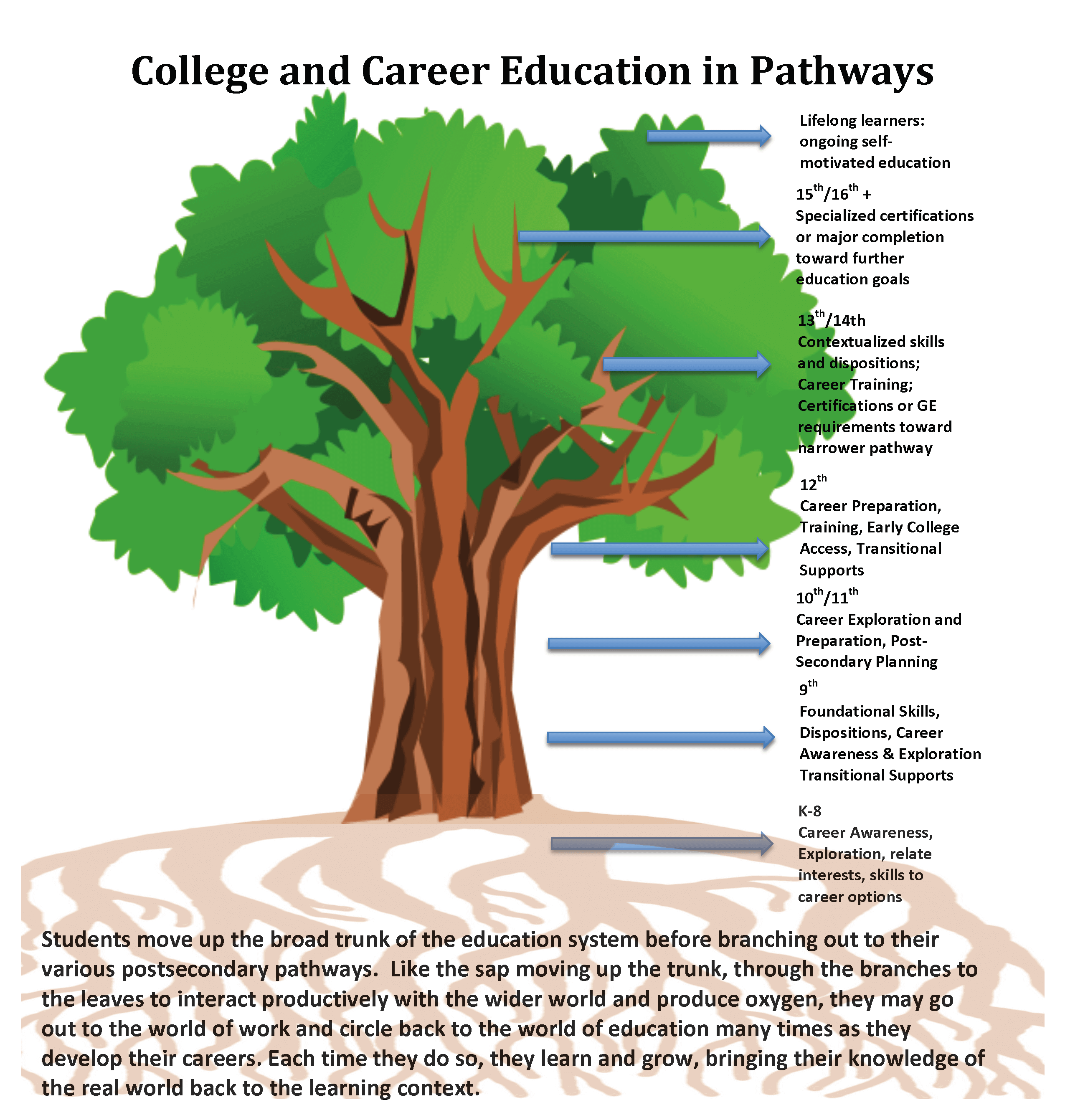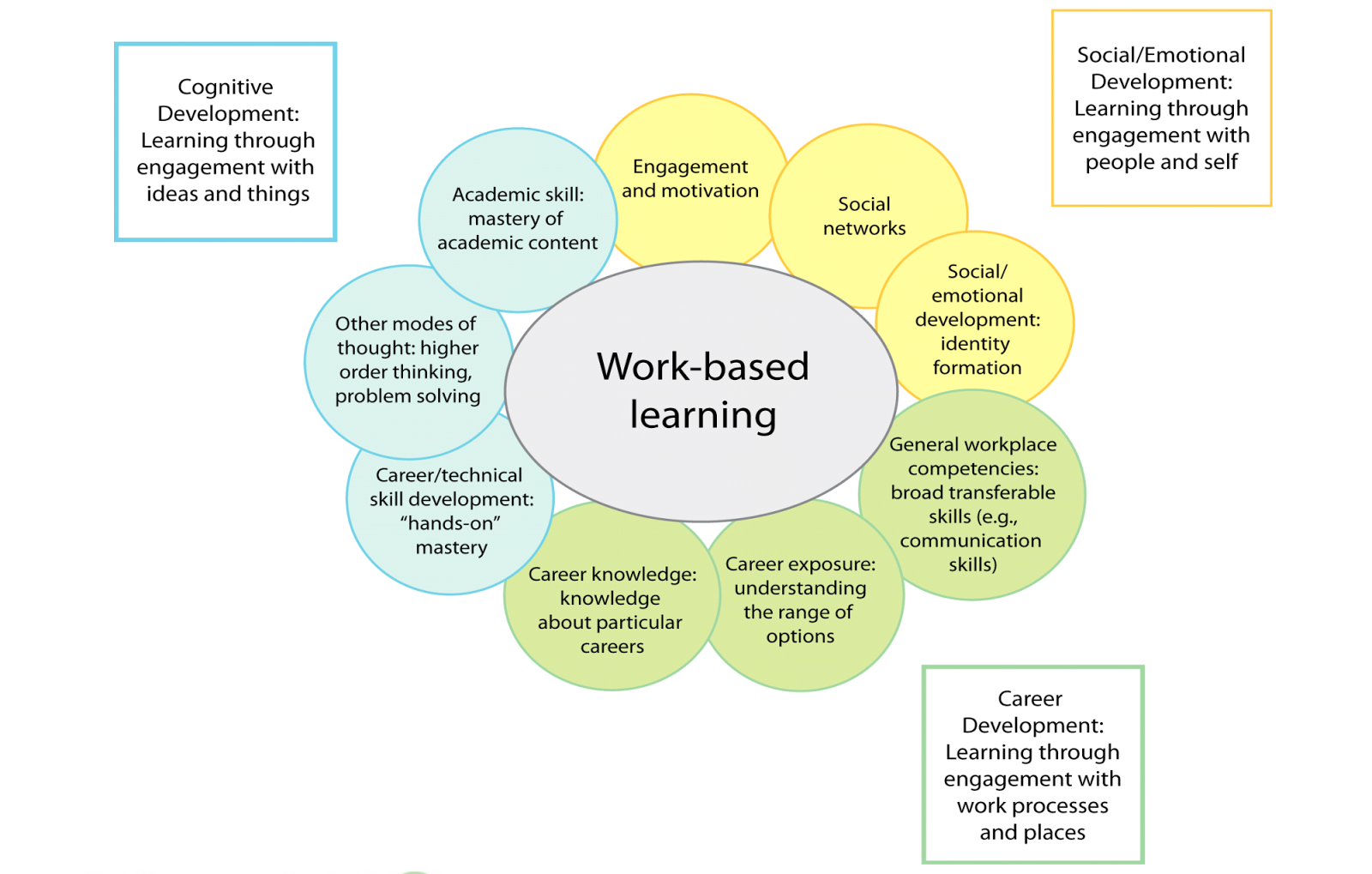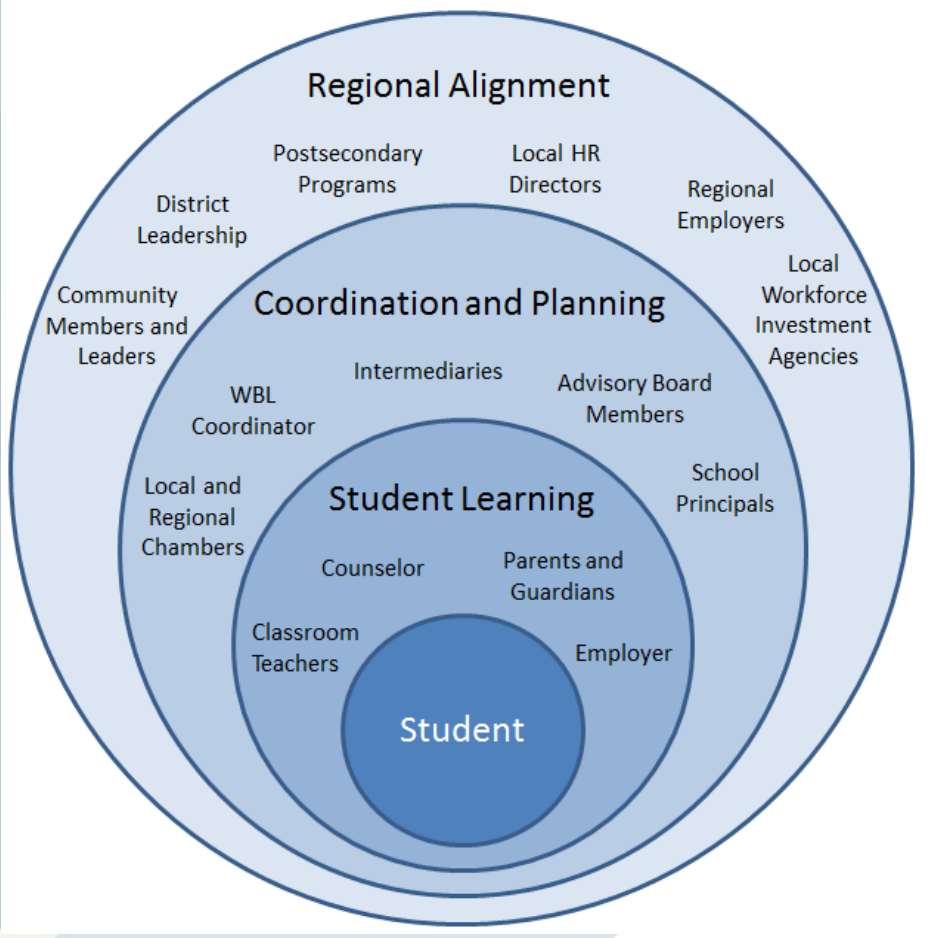College and Career Pathways Leadership Guide
Building Partnerships
Pathway leaders develop relationships with community, industry, and postsecondary partners, as well as with the parents and students in their pathway. Each of these relationships supports different aspects of this complex reform. A pathway Advisory Board is a crucial vehicle for bringing these groups together. However, the purpose and work involved in each relationship differ greatly. 
These partnerships bring tremendous value to the school, and should not take place in isolation. School administrators are responsible for facilitating relationships that connect the school to the community. School site and district leaders can maximize the value of such partnerships by aligning them with school and district priorities, and helping to build them as an integral part of the school system.
Integrating community, industry, and postsecondary partners into the everyday work of schooling is a big change, requiring new responsibilities for some people, and new people in many roles. Such partnerships can completely change how teaching and learning happen, and dramatically improve student success in college and careers.
Pathway teacher leaders need to work with postsecondary faculty to develop early college credit opportunities that facilitate student transitions to college and careers. The postsecondary institutions within a region are natural and essential partners for high school pathways, and can support faculty to refine the academic content, technical skills, and behaviors and attitudes students need to be successful in postsecondary education. Pathway leaders often work with post-secondary partners to:
- Establish early college credit courses in the pathway program of study
- Organize college visits, particularly to postsecondary programs in the career field
- Work with students on college and career planning, including placement and transitions
The document below outlines the specific responsibilities of high school pathway, site and district leaders in developing strong postsecondary partnerships. You can download it here.![]()
 Pathways Across Systems: Increasingly, faculty in both systems are working to build seamless pathways across systems. That work is regional in nature, as the high school pathways in a region all connect to a few local postsecondary institutions with programs in their industry field. For pathways to function strategically, district leaders need to work with pathway leaders in both secondary and postsecondary systems to hammer out data sharing and articulation agreements, and to link career pathway faculty and curriculum so that students can readily progress toward their career goals.
Pathways Across Systems: Increasingly, faculty in both systems are working to build seamless pathways across systems. That work is regional in nature, as the high school pathways in a region all connect to a few local postsecondary institutions with programs in their industry field. For pathways to function strategically, district leaders need to work with pathway leaders in both secondary and postsecondary systems to hammer out data sharing and articulation agreements, and to link career pathway faculty and curriculum so that students can readily progress toward their career goals.
Community Colleges are making many changes in their systems to support this alignment in order to improve the success of students transitioning into postsecondary pathways. This document outlines the changes in work roles that leaders at both the district and college level as well as community college faculty and staff are engaging. Here is a tool that can be used by high school and community college faculty and administrators as they build cross system relationships to self assess the quality of their collaborative relationship, in order to identify strengths and areas for development.
Data sharing: As high school pathway programs embed college courses into pathway course sequence, these agreements allow educators to support student transitions into postsecondary education. They facilitate the use of multiple measures for student placement in college, and the appropriate transfer of college credits earned in high school. Sharing data supports collaboration between counselors across secondary and postsecondary systems, and allows for more accurate assessment of pathway programs that work across those systems. View a sample data sharing agreement here.
Articulation and Dual Enrollment: Pathway teacher leaders collaborating with postsecondary faculty to identify courses that can be incorporated into pathway programs of study for college credit. Access to such courses increases students postsecondary success, but equitable access requires additional student supports for students who have historically been underserved, as explained in this guide. Some key approaches include:
- Scaffold college level content within the program of study
- Embed courses in high school courses to provide collaborating high school faculty and time to support student success
- Align high school pathway curriculum with foundational content needed to pursue all possible postsecondary options
- Contextualize pathway academic courses through the industry field
- Strategically connect teachers across systems, and facilitate regular communication between pathway faculty
- Work with site and district leaders to establish agreements that structure the many details involved in offering college courses to high school students
Course-to-Course Articulation has been overhauled to ensure that more students can access and use credits earned through CATEMA, and a new Articulation Guide is available here. Recent legislation established College and Career Access Pathways (CCAP) Dual Enrollment to support pathway students who might not otherwise access early college credit to be able to do so successfully. When CCAP agreements between secondary and community college districts are developed both institutions are able to access resources, and classes can be offered to high school students within the school day. A new Dual Enrollment Toolkit is available here.
Mapping Pathways Across Systems: Previously, comparing high school and college-level pathway curriculum has primarily happened in the articulation process. However, faculty have begun aligning curriculum in a more comprehensive fashion, through Pathway Communities of Practice (CoP) within industry sectors. CoPs provide the opportunity for pathway leaders to learn about each other’s systems, and to align their programs of study. For example, see this vision statement and outcomes from a health pathway CoP. The process of developing seamless pathways across very different educational systems is complex and challenging, but it starts with engaging faculty leaders at both levels in developing a vision for college and career education in pathways. The Career Ladders Project has developed a pathway mapping toolkit to support this process step by step.

Pathway Mapping: A common initial activity for CoPs is mapping the pathway, as in this map developed by West Contra Costa USD and Contra Costa College faculty with the support of the Career Ladders Project (CLP), for Public Service and Law pathways. Maps for many sectors developed with CLP’s support can be found here. Postsecondary pathway maps serve students best when they include general education requirements and the full range of pathway options, with “stackable” certificates so that students can build toward their career goals incrementally, as seen in Long Beach City College’s Allied Health Pathways map. This work opens opportunities for improving student access to advanced coursework through dual enrollment and articulation, as can be seen in this map of high schools that have articulated courses with Long Beach City College.
High quality high school pathways differ from most postsecondary pathways in that academic courses are fully integrated into the pathway program, and the teachers collaborate in interdisciplinary teams. While they may not teach all classes students take, the team plans the learning sequence to ensure that all students have access to both college and career preparation, to advanced coursework and student supports, and to the wide range of postsecondary options. The high school pathway map is an invaluable tool in discussing the pathway program, and articulating instruction in the essential foundational skills required for students to be successful in a wide range of pathway options. The California Department of Education has also developed a valuable tool for planning pathway programs of study across secondary and postsecondary, available here.
Work-Based Learning (WBL): Active and consequential engagement with the world of work and community outside of school enhances student learning in school. When students connect their interests and concerns to preparation for their futures, they are more motivated and goal oriented, and more prepared for postsecondary opportunities. Changing schools so that real world work-related experiences are integrated into instruction is a huge change for schools.
The role and value of CTE is increasing as schools build upon CTE teachers’ knowledge of and connection to career fields, particularly since Common Core state standards emphasize real world applications of academics. CTE teachers often run internship programs (see CCASN’s Internship Guide), bring in guest speakers, organize career days, and other activities that connect pathway students to the real world of work. CCASN provides a Toolbox of resources for teacher leaders building industry and community partnerships.
Scaling up this valuable experience so that all students have opportunities to connect academic learning to career possibilities that interest them entails a broader vision beyond that of the individual pathway programs. High-quality work-based learning benefits students’ cognitive and social/emotional development, and supports them to develop career aspirations and educational goals. Both college and career readiness are now indicators of school quality, encouraging the inclusion of career education within the overall program of study for all students. As college and career pathways expand within high schools, many districts are also expanding WBL resources, including hiring new WBL coordinators and industry specialists to develop and manage relationships with industry partners.
Research on Linked Learning pathways and districts points to the fact that high quality WBL experiences are often not equitably accessible to all students, nor integrated into classroom instruction. (Lafors 1) Ensuring equitable access to valuable WBL experiences is foundational to the success of college and career pathway development.

Infusing WBL Into Classroom Instruction: Community and industry partnerships in pathways can transform teaching and learning by:
- Linking classroom academic content to real world contexts
- Helping students identify and practice the skills required in a career field that interests them, as well as skills transferable to many fields
- Facilitating students’ self-assessment of their strengths and passions, and goal definition
- Involving professionals and employers in mentoring, providing hands-on learning experiences, and contributing to curriculum development and assessment processes
Teacher leaders work to connect community and industry partners with their teams to infuse Work-Based Learning (WBL) into all pathway courses because WBL:
- Links school-based instruction with activities that have consequences beyond the class or value beyond success in school
- Uses the workplace, or in-depth experience with employer or community input, to engage students and intentionally promote learning and access to future educational and career opportunities
These Work-Based Learning Definitions, Outcomes, and Quality Criteria are helpful in integrating high quality work-based learning experiences into the core vision of schools.
District Supports: Incorporating industry and community partners in the classroom takes a lot of coordination, planning and support. Teacher leaders cannot do it all. A system of support for WBL requires action from many people at the site, district and regional level. An excellent guide to Quality Work-Based Learning is available here.
District supports for teacher leaders in this work include:
- Engage principals in learning about how to infuse work-based learning into their leadership responsibilities, including providing equitable student access to high quality work-based learning.
- Provide dedicated staff to connect industry partners to pathway teams,
- Develope collaborations with Workforce Investment Boards and community based organizations to work with students on career education and WBL
- Provide guidelines for teachers to tie academic outcomes to the specific activities, such as these created by OUSD
- Support teachers to add credentials that allow them to teach integrated academic/CTE courses;
- Create programs that engage teachers in learning about workplace standards in their industry field through direct workplace experiences, such as job shadowing and externships.

Because pathways work with a cohort of students over several years, pathway teachers come to know students, and often their families, more personally than in the typical comprehensive high school. This deeper personal connection also opens the door to empowering relationships with both students and parents as partners in the learning community.
Students: Leadership development activities are commonly integrated into pathway communities of practice. For example:
- Student organizations that connect students with future career options,
- Community service opportunities built into project-based curriculum,
- Participation in school leadership committees and decision making bodies
- Explicit instruction in teamwork, presentation and other skills essential for success in the work world
- Recruitment and orientation of new students to the pathway
- Organization of community-building programs and exhibitions that invite families to share in the learning going on in pathway classrooms
Each of these activities strengthens the pathway’s success with all students. Faculty from the pathway teacher team who take responsibility for helping to build student leadership should be recognized and compensated for this essential work.
Parents: Parent involvement increases student success. Five key parental involvement strategies that significantly improve student success in middle and high school, which pathways are well designed to support:
- Proactive/preventative communication with teachers,
- Quality of communication between parents and teachers
- Scaffolding independence (encouraging youth to take responsibility for their schoolwork)
- Providing structure at home
- Linking education to future success
For parents, schools can be formidable institutions, and may even be foreign territory. This is why schools are mandated to establish programs to support parent involvement. But a pathway teacher team can support parents’ access to the information and resources needed to participate as equal partners in educating their children.
Critical principles for parent involvement include:
- Providing consistent accessible communication in the languages spoken by the families in the program
- Make sure parents serving on committees reflect the make-up of the student body, and have access to training and support
- Provide avenues for communication to go BOTH ways, from school to home and from home to school
Schoolwide structures set up to support parent engagement also have to adjust as pathways grow, so that the personalized nature of pathways can increase parent involvement overall. More translators, more communication between programs, and coordination of efforts are needed if pathways are to facilitate parent empowerment.
Some things parents can bring as partners to the pathway learning community:
- Serve on Advisory Boards
- Help make decisions about the pathway program of study
- Serve on school-wide committees and governing bodies
- Serve as guest speakers, or resources to access guest speakers
- Provide services to support the learning community, e.g. technological support
- Help to organize community-building events
- Help to engage students in real-world projects, as data sources or mentors
- Help to critique student work
- Chaperone field trips
- Support classroom discipline when teachers are meeting and subs abound
Participation of site administration in pathway Advisory Boards can be a valuable way to ensure that pathway programs are connected to a common site vision. Working with pathway leaders on the Advisory Board provides an effective avenue for oversight, and a concrete way to support teacher leadership development. Regular Advisory Board meetings serve both the pathway and the school. They allow site administrators to:
- Monitor equitable access to post-secondary planning and work-based learning resources
- Establish a direct communication channel for information about industry, post-secondary and community partnerships
- Maintain oversight of the various funding sources specific to pathways, such as are provided by industry or community partners
- Increase diverse family involvement in school activities and decision-making
- Create strong relationships with pathway leaders, partners, and families
Supporting pathways to develop and maintain strong advisory boards requires a commitment from site and district leaders to provide teacher leaders with adequate common planning time, compensation for work outside the contracted school day, and partnership in the process of establishing these avenues for industry, community and post-secondary involvement in the high school context. See this Parternship Guide for more on working with industry partners and creating Advisory Boards.
